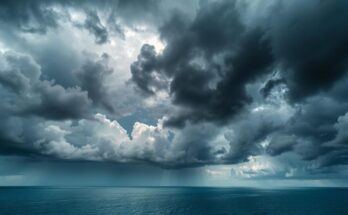A major winter storm is about to affect the mid-Atlantic, especially Virginia and West Virginia, with significant snow and ice accumulation expected. Governor Glenn Youngkin declared a state of emergency, allowing local governments to receive state aid. Travel dangers, potential power outages, and flooding are significant concerns, while communities across states prepare for severe cold and further storms.
A significant winter storm is imminent in the mid-Atlantic states, prompting warnings from the National Weather Service regarding hazardous travel conditions from Tuesday to early Wednesday for Virginia and West Virginia, with substantial snow and ice accumulations anticipated. Virginia’s Republican Governor Glenn Youngkin has declared a state of emergency, enabling state agencies to support local governments in managing the storm’s impact, which has already led to the closure of schools and government offices statewide.
Forecasts predict up to 10 inches of snow in northern and central Virginia and eastern West Virginia, alongside heavy ice buildup, especially in the Roanoke Valley, which could lead to power outages and damage to trees. The weather service’s Blacksburg office humorously commented on social media about the unexpected continuation of winter, as snow and sleet began affecting road conditions early Tuesday.
Appalachian Power has mobilized resources, requesting 700 additional workers from neighboring utilities to address potential operational challenges. Meanwhile, East Tennessee faces an escalating flood threat, with up to 8 inches of rain projected through the week; necessary measures are being implemented to mitigate the risks of flooding.
Portions of the George Washington Memorial Parkway in northern Virginia have been closed due to safety concerns stemming from potential abandonment of vehicles during the storm. Winter storm warnings extend from Kentucky to southern New Jersey, and flooding watches have been issued for Kentucky, Tennessee, southwestern Virginia, and northern Georgia, with conditions expected to improve as temperatures rise.
A separate storm system is predicted to impact areas from Kansas and Missouri up to the Great Lakes on Wednesday. The National Weather Service has also issued warnings about extreme cold due to an Arctic air mass affecting regions from Portland to the Great Lakes, with tragic reports of fatalities due to cold exposure.
Portland, Oregon plans to open severe weather shelters as temperatures are predicted to drop significantly, necessitating outreach efforts to assist vulnerable populations. The weather service provides additional alerts forecasting freezing rain in the area, along with a possible influx of precipitation over the weekend.
In Montana, temperatures are projected to plunge to minus 33 degrees Fahrenheit, prompting local organizations to distribute cold-weather gear to support the homeless population. In California, forecasters are preparing for an atmospheric river expected to bring substantial rainfall and snow to different regions starting Thursday.
The impending winter storm poses significant challenges for the mid-Atlantic states with forewarnings of hazardous travel, power outages, and safety risks due to ice and snow. Governor Youngkin’s proactive measures through an emergency declaration and the mobilization of resources underscore the seriousness of the situation. However, there are broader impacts across various regions, highlighting the need for community support and preparedness amidst these severe weather events.
Original Source: www.pbs.org




